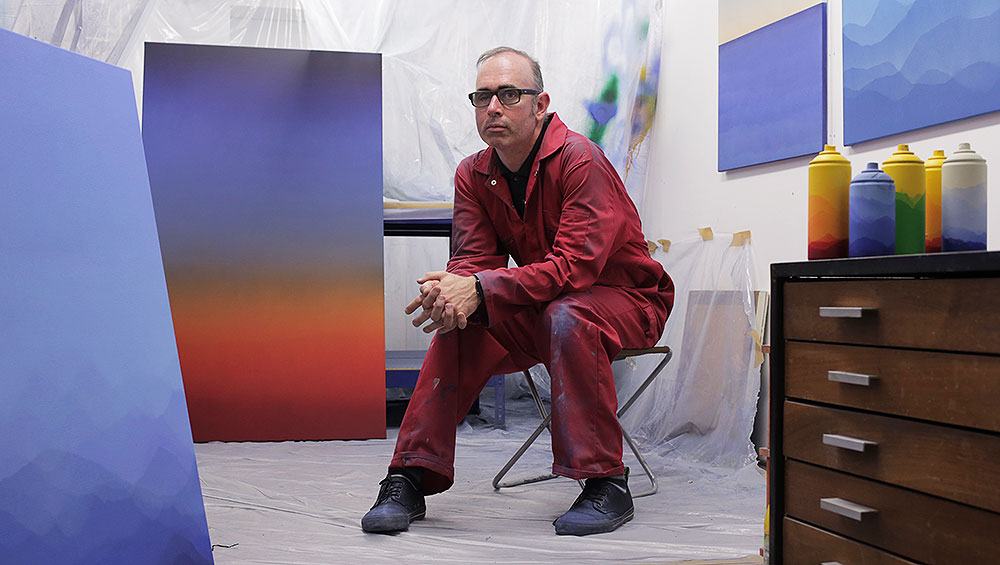
Matt Jukes in his studio. © Matt Jukes.
by ANNA McNAY
Matt Jukes (b1976, Bougainville, Papua New Guinea) came to London, from Melbourne, in 2004, for a one-month holiday. While here, however, he visited the Rothko Room at Tate Modern and immediately knew he couldn’t return home. He has since studied printmaking at Morley College (having already read design at Royal Melbourne Institute of Technology), and his work continues to be influenced by that of Mark Rothko, with its roots in layers, colours and emotions.
Feelscape is Jukes’s first venture into visually representing how memories and emotions change over time. An algorithm he created, in collaboration with the creative developer Jop Wielens, uses the participant’s webcam to analyse the relative positions of their facial features as they recall a chosen memory. These are then rated against the typical expressions of six key emotions – happiness, surprise, sadness, anger, disgust and fear. In the algorithm, each emotion has been assigned a colourway [series of colours], and the resultant artwork – an abstract landscape produced in their browser – is a blend of these.
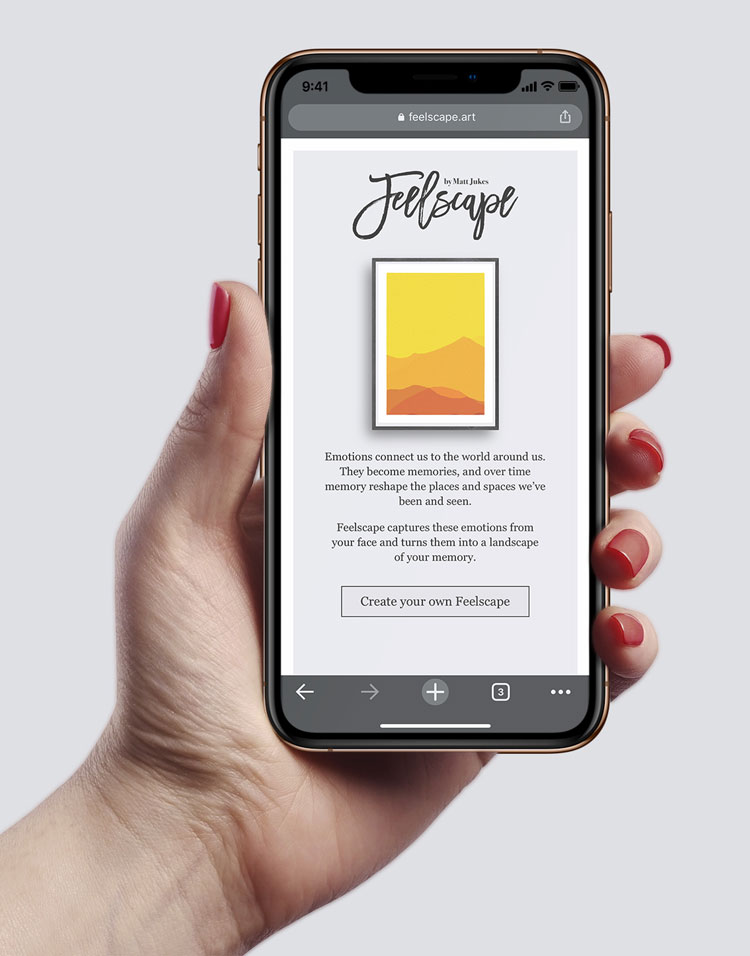
Matt Jukes. Feelscape (feelscape.art). Photo © Matt Jukes.
Jukes spoke to Studio International about his new work, his concern for people’s mental health during the pandemic, how memories are continually formed and reformed, and his plans for after lockdown.
Anna McNay: First of all, can you explain a little about what Feelscape is and how it works?
Matt Jukes: Feelscape, in the simplest of terms, is about being able to connect people with the environment around them. I’m using some clever bits of AI, which are able to take the expression on your face as you recall a memory and turn it into an imagined landscape. Feelscape enables you to capture that memory through the emotions you felt at the time. I invite the viewer to sit and take a couple of deep breaths, to look at their screen or webcam, and to remember what they felt at a particular moment in their life. The AI algorithm then looks at the different shapes and forms of their facial expression and brings those together to create a visual representation of the memory.
AMc: We will break this down further in a moment, but, to begin with, how does someone access Feelscape? Do they just go to a website?
MJ: Yes. It’s all accessed through the website feelscape.art. You can do it on your phone, on a computer, or on any device. I have plans for an exhibition, but that’s just ticking away in the background at this point. For now, people are able to go to the website, and, once there, click on a button, which will open their webcam and take them through the process of being able to capture their emotions of a memory.
AMc: Are they free to choose whatever memory they want?
MJ: Yes. I don’t specify that. It’s really a space for them to be able to sit, breathe, pause for a second, and remember. This all came out of lockdown, and how our memory is becoming a little bit faded and confused. I wanted to help people reconnect with their memories. I haven’t dictated that they must remember a happy memory or a sad memory. It’s about being able to get people to almost meditate on these memories, to cement them in their mind, and then to give them a visual representation.
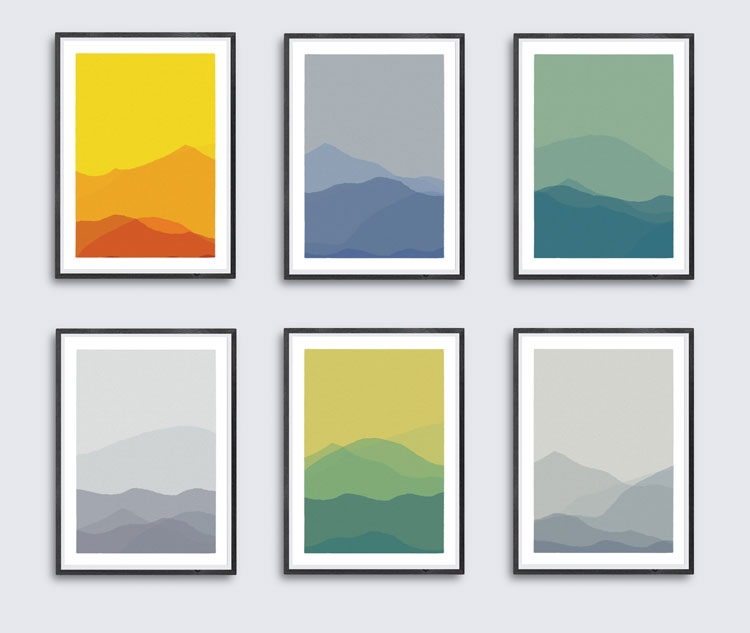
Matt Jukes. Feelscape outputs. Photo © Matt Jukes.
AMc: You worked with six key emotions – happiness, surprise, sadness, anger, disgust and fear. How did you select these?
MJ: We use the AFFDEX algorithm, which classifies emotions from facial expressions. These are the six emotions it gives us, which we then use as input for Feelscape. I have just used it to be able to read emotions, but there is a whole host of other information you can garner from looking at someone’s face, which I find absolutely fascinating. This is the same kind of generator that is used across Facebook and a host of other sites to be able to look at your pictures and say: “That’s a happy person, that’s a sad person, that’s a woman in her 30s, that’s a man in his 60s,” and so on. Basically, it gives you a series of variables, and then it’s the AI which takes those variables and turns them into the colours and the landscapes.
AMc: It sounds as if you know what you are talking about with regards to the AI, but you nevertheless produced the algorithm in collaboration with a creative developer, Jop Wielens.
MJ: Yes, he is a developer I have worked with for years, and he is also a very good friend. He makes lots of games and things like that. We had been talking about projects to work on together for ages, and this was the first time his schedule was free, my schedule was free, and we were able to get together and make something. It was wonderful to work with such an incredibly talented person, and it became a backwards-and-forwards collaboration, which reinforced the importance of working in a community of creative people, as well.
AMc: To go back to the six emotions – happiness, surprise, sadness, anger, disgust and fear – I was surprised there were so many more negatives than positives in the mix.
MJ: I find that really interesting, too, but, once again, it’s the way in which all the various emotion-tracking services break them down, and I think it comes down to the general features of someone’s facial expression. And you’re never 100% happy, so there is always a mixture of these basic emotions.
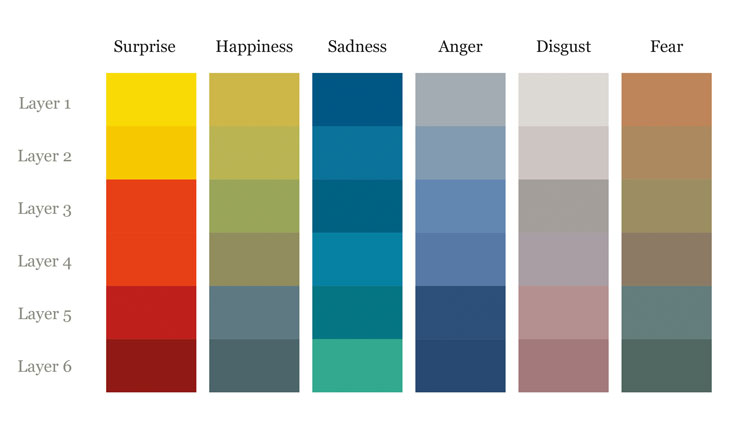
Matt Jukes. Colours vs emotions. Colourways assigned to emotions in the Feelscape algorithm. Photo © Matt Jukes.
AMc: The code you built takes the series of numbers tied to the six emotions you receive from AFFDEX and maps these on to a colourway, which is basically a series of colours.
MJ: Yes, so the AFFDEX code looks at your face and things such as how open your mouth is, whether you are smiling, how raised your eyebrows are, how open your eyes are, etc, and it works out a percentage of how happy, how sad, how disgusted it thinks you are. It gives me those variables, and I map them against the colourways. I created all the colourways and chose which colours I wanted to represent the broad brushstrokes of the emotions. But, as I say, no one is ever 100% happy, so then it’s a case of mixing the given percentages of the different colourways together to create something that is unique for that person.
AMc: And all of this happens within the participant’s browser?
MJ: Yes, everything happens just in the browser session of the user. Nothing is saved to the server unless you choose to purchase the print. Then we save your unique image.
AMc: As you say, you know which colourways are linked to which emotions, but, if someone didn’t know this, would they be able to tell what kind of memory the landscape was drawn from? I mean, is it as simple as, say, greys and browns being representative of sad memories and reds and yellows of happy ones?
MJ: Yes, the happier memories do tend to be the stronger, brighter colours – the yellows, reds, pinks and oranges, and the sadder memories are typically deeper blues and greens.
AMc: Theoretically, someone could repeat the “exercise” as many times as they wanted, either just because they find it fun, or because they want to get to an image they are happy with.
MJ: Exactly, and what I love is that people do just that. They move their face around and play with the emotions they are experiencing. That, in itself, is fantastic, and lots of people have been sharing screengrabs of their results. But, yes, if they feel that special connection with the piece, they do have the opportunity to buy it. What happens then is I create a one-off, unique, A3 giclée print of their landscape, for the cost of £150. I wanted to make something that is easy enough for someone to add to their collection without completely overwhelming them, and I wanted to offer it at a price that is accessible to everybody – I think that’s really important. I don’t want this to be something that only those with lots of money can do.
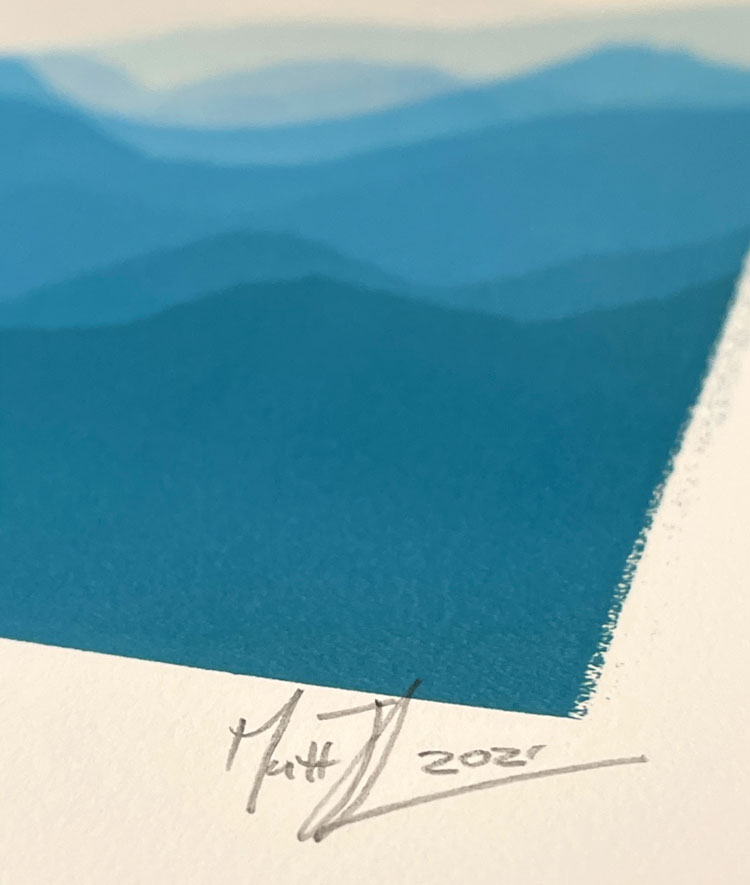
Matt Jukes. Feelscape output - detail showing signature. Photo © Matt Jukes.
AMc: What, for you, is the work? Is it the print that ultimately may or not come out of someone’s participation, is it the participation, or is it the algorithm?
MJ: I think it’s the participation. I suppose, at the heart of that, is the algorithm, but I am very much about being able to let the viewer interpret my work. Through all of my printmaking, and the other parts of my practice, there is a lot of looking at how the viewer is able to interpret the work and see their own location in it. What I love about Feelscape is that it turns this around and allows the viewer to create their own location. So the important part is the role the viewer plays within this experience. That is the art. The extension of being able to take it home and hang it on your wall is obviously a more permanent reminder of that, but the overarching goal is to enable people to capture a moment, or that feeling of a place. I’m really interested in the way in which we, as people, collect objects and store memories inside those objects, because, realistically, all these things are just a bunch of atoms. Look, for example, at all those books behind you. There’s a story attached to every one of them – about the time you bought it, who gave it to you, the time you read it. The whole notion of storing thoughts and memories inside objects is something I’m trying to connect with here. That’s the reason I came up with the idea of having a print – an object – which you can take away and use to reconnect you to that memory every time you walk past it on your way to the kitchen. Again, I’m just saying: “Pause for a second, remember that time, feel those emotions again before you go and continue making your cup of tea.”
AMc: How does Feelscape fit into your wider practice? You just touched on the role of the viewer and memory …
MJ: Yes, exactly. My wider practice is very much about the way in which we remember things, and, more specifically, the wilful misremembering of things. I try to capture the emotional feeling of a place, rather than a physical representation, and, in that, I invite the viewer to find their own place, but to feel the same emotion that I have imparted into the piece. What I love, with each one of my pieces, is that everyone will have their own story of it. Even my most literal pieces have a wide reading.
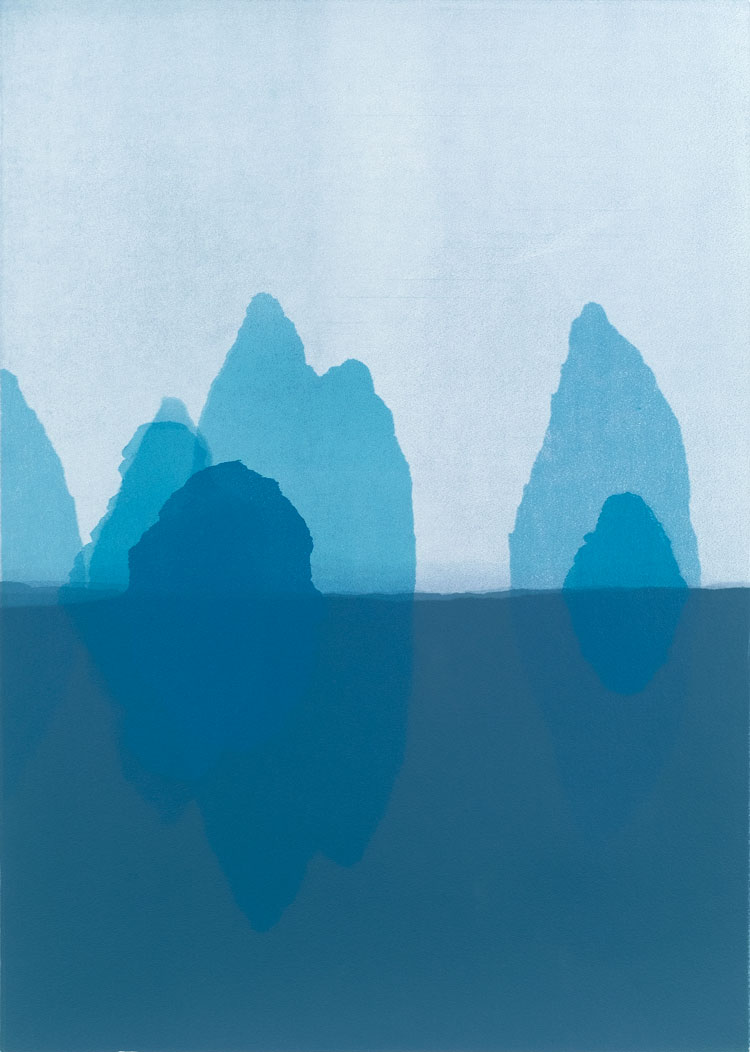
Matt Jukes. How Long, 2019. Monoprint on 300 gsm hahnemuhle, 73 x 53 cm. Photo © Matt Jukes.
The best example I can give is a series of monoprints I did about Ha Long Bay, off the north coast of Vietnam. If you don’t know it, you need to stop everything and go there right now. It is a fantastic place. Don’t worry about the pandemic, just leave that behind and head there right now! Ha Long Bay, in Vietnamese, means Dragon Bay, and these rocks come out of the water as if a dragon has curled up and you can see the arches of its back. When I was there, it was very misty, and as we kayaked through the rocks, each one appeared out of the mist and disappeared in turn. It’s a really magical place for me, and I have done a whole series of pieces around it. But what I love is how other people refer to them. One person thought they were icebergs, another said it was the coast of Michigan. I love the fact that this same image, this same misty, ethereal feeling of these monolithic figures rising up from the horizon, can be read in so many different ways. I suppose that’s what I am talking about as far as bringing people together, seeing the same thing, but seeing different locations.
AMc: Absolutely. And you said that this series is not digital, but monoprint.
MJ: Yes, the majority of my practice is lithographic monoprints. I use a 200-year-old machine to build up layer on layer of ink, and, each time I put down a layer, I strip a little bit off. It’s like the idea of building up memories, and, as I build up the memories, they get a bit faded. I know when it’s finished because I have that moment of: “Oh, that’s the memory. That’s the feeling.” Usually it’s associated with some kind of music. I hear a line go through my head from some obscure song I listened to when I was 15, and then I’m instantly back in that moment, back in that place, and I know this is the emotion I have been searching for, and this is now a finished piece. It’s wonderful to have that conversation with the work as someone who is making it. You can have a vision of where you want to go, but really the work is going to dictate it to you, and you need to be able to respond to that and take all of those many turns as you work your way through it. That’s very much the way in which I work.
AMc: I remember when we were talking before, and you said that, when we remember a memory, we are not remembering the event or moment itself, but the last memory of that event, in this long chain of memories of memories. So we are actually misremembering, because it’s the memory of a memory of a memory … Is that what you meant by “wilful misremembering”?
MJ: Exactly. Even now we are thinking back to that last conversation we had, and we are overlaying a different context on top of it. Every memory you have is completely unreliable because you have layered its context. And so, even if two people are in the exact same spot at the exact same moment, their memory of that situation is going to be completely different in 20 years’ time, because they keep on layering all these different emotions on top of it. I love this idea of the blurring of memories and the unreliable narrator. You think your memories are rock solid. You think you know your life. You think you know what’s going on, but you don’t. These are just a series of impressions that you are continually remembering and reinforcing. Otherwise your brain will let them go, and they will fade away. It’s an interesting lesson about living in the moment because this moment now is the only moment which isn’t a memory, which hasn’t be rewritten and reworked.
AMc: You did some research into how the pandemic is affecting our memories, and how it will leave many of us with a huge blank in years to come.
MJ: Yes, as you can probably tell, I read a lot of research about the brain and the way it works. I find it absolutely fascinating. Because our brain needs constant stimulation to be able to write memories, and, because, on the whole, we’re not getting out of our homes much, or providing this stimulation at the moment, psychologists are predicting that the whole pandemic will be largely forgotten in a couple of years. We simply will not have had those new stimuli coming in every day. I mean, look at the number of people who don’t know what day it is because everything is merging into one. That is a perfect example of the lack of stimulation. There’s a certain routine that has kicked in, which means you will remember the pandemic by your daily hour of exercise and then just sitting at home at your desk. It is quite far down inside the reptilian part of the brain, this part which basically enables you to store only the things you need to know about. If you’re going along and see a big sabre-toothed tiger coming at you, for example, you’re going to store that information in your brain because you don’t want to go back there. Whereas if all the walking you need to do is to find nuts and berries, you’re going to forget it, because you don’t need that information.
AMc: How do you think this – and the pandemic more generally – is impacting on people’s mental health? There is unsurprisingly something of a crisis going on at the moment.
MJ: Yes, there’s a massive crisis in mental health at the moment because of the weight of living through this pandemic. I think that these kind of mental health issues are, once again, caused by the monotony and by not having a clear idea of when we are going to get out of this, or how are we going to move back to normal, or even if there is ever going to be a new normal. This uncertainty pushes you into a negative space. I suppose the important thing to remember is to be able to find the joy inside the everyday, the joy inside those little moments. I’m no psychiatrist, but I think that, with clear direction, you are able to hold back those – what did Churchill call them? – mental black dogs. I think you can hold them at bay by being able to find peace inside the moment.
AMc: Which, coming back to Feelscape, was part of the inspiration.
MJ: Exactly. I wanted to help people find that moment, to think of better times, and to feel that connection back to their reality, as opposed to getting lost inside the doomscrolling of the news at the moment. It is a break away from that, to give people a moment to breathe. That’s the reason I brought a bit of meditation into the process, where I ask the participant to sit, pause and breathe, to bring that sense of being alive back to them. I’m hoping this work will have a positive effect on people’s mental health, or at least give them a little bit of respite, and to enable them to fulfil their wanderlust and travel without leaving their sofa, as well.
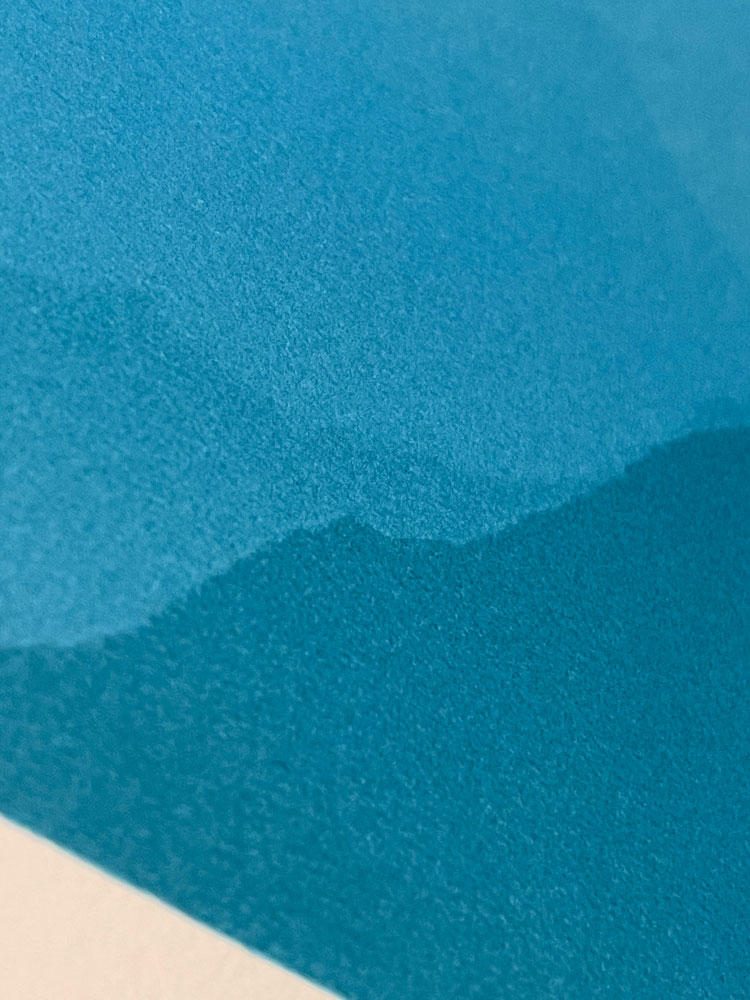
Matt Jukes. Feelscape output - detail showing texture. Photo © Matt Jukes.
AMc: The landscapes you create are very abstract. I know you were greatly inspired by Rothko. Is he still a key influence?
MJ: Yes. I find the way in which his works sing and dance absolutely magical. One of the reasons I ended up living here in London is Rothko. I had studied him throughout my art college years, but I never really liked his work, because I was only seeing reproductions in books, and they just didn’t make any sense to me. It wasn’t until I arrived at Tate Modern and was standing in front of his Seagram Murals, that I had that moment where I realised: “Oh, this is what everyone is talking about!” I was incredibly taken aback by his ability to use colours to portray emotions and to physically shift you, by the sense of scale. I’ve obviously borrowed that idea of using colour to connect people with abstract landscapes, because colour is the surest way to build that connection with an emotion. My landscapes are abstract and minimalist, but it’s very much like looking at the landskein and the layering of all of the different elements of the land. That is what allows people to see their own locations inside each of these places, I think. They’re much more like colour fields, seeking to trigger emotions, rather than trying to depict the trees and rolling hills of this green and pleasant land.
AMc: You mentioned earlier that you have plans for an exhibition at some point.
MJ: Yes, that’s what I’m working on at the moment. I want to be able to put together a space where the experience goes from your computer screen to surrounding you completely. I’m looking to build a room where you walk in, and it reads your emotions in real time, then projects it on to the walls in that moment, and so, as you change your expression, you see the walls shift and change as well. I am hoping to have that together once we come out of lockdown. There are a lot of things to fall into place before it happens, but I am rather excited about being able to create this immersive experience, to allow people to step outside their screen and be surrounded by these wonderful, emotive colours, reflecting their emotional state. I am toying with the idea of using music and movement, as well, because these are different ways of linking back to memories. I love the idea of using music to get people to move their bodies – almost like a form of dance. Like those times when you’re so excited you just jump up and down. Those are the things I am working on at the moment. Fingers crossed it will come to fruition, and it can become something big and exciting. As an artist, I think it’s important to continue experimenting, and you need to be able to dream big, so you can shoot for the stars, and maybe reach the moon – and that’s OK. Not that long ago, I wouldn’t talk about the things I was planning, but now I think it’s really important to put a stake in the sand and say: “This is what I’m heading towards, this is what’s exciting me at the moment.”
• For more information see https://feelscape.art
Click on the pictures below to enlarge